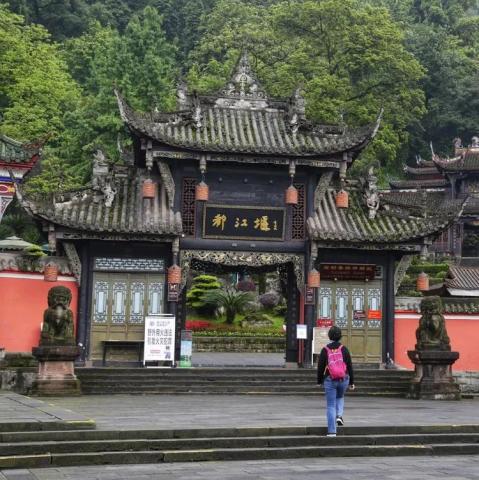
Dujiangyan, a city named after an ancient super water conservancy project.
The construction idea of Dujiangyan is to follow the trend and build according to the water.
Yuzui, Feishayan, Baopingkou, and other auxiliary facilities are the entire project.


This is the fish mouth: it separates the inner and outer rivers.

Feishayan: borrow water to discharge sand.

The schematic diagram found online is more intuitive.

Baopingkou: dug into the mountain.

Li Bing controlled floods, and his six-character formula for controlling weirs is engraved on the stone wall of Erwang Temple.

The standard for beach surfing is the horizontal iron under the weir.

If you go to Dujiangyan just to follow the tour guide to the scenic spot to listen to Li Bing's story and see the composition of the water conservancy project, it will be somewhat boring.
You might as well go to the West Street in the city to have a look. You must know that the city of Dujiangyan was not born because of the weir.
The history of this ancient city predates the construction of Dujiangyan far, far away.
Dujiangyan West Street is across the river from the Dujiangyan Scenic Area. In Chengdu, which has many ancient towns and streets, it can be said to be unknown. However, this humble old street carries a rich history of 5,000 years. The ancient Shu people once went down the mountain through this old street and entered the Chengdu Plain, creating the splendid ancient Shu civilization.
The red line in the picture is West Street. It is adjacent to Yulei Mountain in the north and Minjiang River.

It faces Fulong Temple across the river.

It is accompanied by the South Bridge.


The old street with bluestone road lies quietly at the foot of the green Yulei Mountain.
Most of the houses on the street are wooden houses with a history of more than a hundred years. Fortunately, the "5·12" earthquake did not cause much damage to them.


Stay at the end of West Street, at the foot of Yulei Mountain, in this B&B called "Yinxi Mountain Stay".
During the day, when you open the door and see the bustling scene,
Enjoy the tranquility behind closed doors at night.


Next to the B&B is the Mountain Gate. West Street is the starting point of the Southern Silk Road into Tibet. Across the mountain gate is the Songmao Ancient Tea Horse Road.
This road is more than 700 miles long, connecting Songpan and Maoxian. According to historical records, it has been a commercial thoroughfare and a military thoroughfare since the opening of the Shu-Han Dynasty in the Three Kingdoms. During the Three Kingdoms period, Ma Chao, one of the five tiger generals of the Shu army, led his army to garrison Dujiangyan from then on.
Along with the smoke and clouds of history, the 700-mile Songmao Ancient Road has been annihilated in the mountains. Only the section behind the mountain gate from Yulei Pass to Erwang Temple still has some residue.


Yulei Pass, "the key to western Sichuan", strangles the throat of the Ancient Tea Horse Road and has a history of more than 1,100 years. Du Fu once wrote in a poem titled "Climbing the Tower" that "Flowers approaching tall buildings hurt the hearts of visitors, and it is difficult to climb here. The spring scenery of the Jinjiang River comes to heaven and earth, and the floating clouds of the jade barrier change the past and the present."



The narrow West Street under the mountain gate has an antique look with blue bricks and black tiles; it is quiet and simple with simple calligraphy and light ink rhyme.
In the morning light, the blue of the sky is printed on the bluestone, which is the tranquility of purple.


At the corner of West Street, there are rows of food stalls on one side, many of which are time-honored, with reasonable prices and good taste.



On the other side is a section of city wall, which originated from the Tang and Song Dynasties and started in the Ming Dynasty.
Walking up the stone stairs to the city wall, it was quiet and deserted. The blue-grey bricks are the weight of history, and the densely packed cobblestones are the symbol of Dujiangyan.
The city wall does not lead directly to the top of the mountain, but only for a short distance, then it turns around and becomes a short road. Walking all the way down, you will reach the Minjiang River.


On both sides of the street are mostly one- to two-story wooden houses, still brown, with red lanterns hanging high under the eaves, which should be the style of old Chengdu.

The deep alleys are filled with faint fireworks. Occasionally pedestrians pass by leisurely, leaving their vague memories in time...








On rainy days, West Street has a bit of Jiangnan Rain Alley flavor.


In two days, I saw a large number of tour groups pouring from South Street next to West Street towards the gate of the scenic spot like a tide. My best friend and I quietly wandered on the bluestone road of West Street, wandering in the mottled West Street. In the mossy alley.





Walk slowly and take a closer look:
The bluestone under your feet is shiny, having accumulated thousands of years of vicissitudes.
The lanterns on the eaves glowed red, illuminating the century-old alley .
Mottled by years, feathered by time,
Dujiangyan,
A place worth calming down and experiencing.
